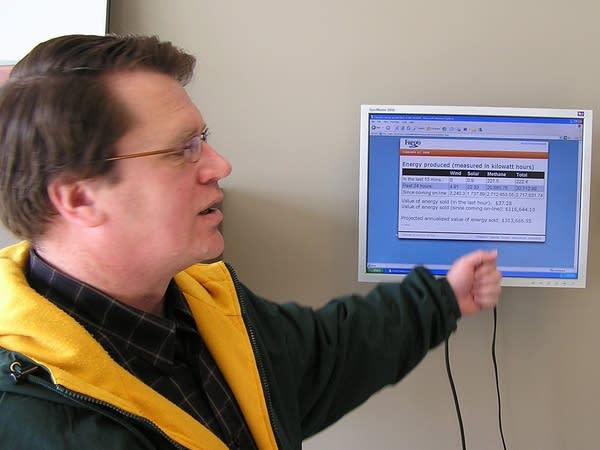Cashing in on global warming

Dale Enerson is a farmer who's concerned about the environment.
He practices no-till farming, which means his fields aren't plowed and each year's crop is planted in the residue from the previous year.
He sees many environmental and financial benefits.
"My land is eroding less, there's less runoff and I'm using half as much diesel fuel as I used to to do my crop operation," says Enerson. "I'm throwing those environmental benefits in for nothing in return for selling some carbon offsets."
Create a More Connected Minnesota
MPR News is your trusted resource for the news you need. With your support, MPR News brings accessible, courageous journalism and authentic conversation to everyone - free of paywalls and barriers. Your gift makes a difference.
Carbon offsets are what Dale Enerson earns for storing carbon in the decomposing plants on his farmland.

For each acre of land he earns carbon credits he can sell on the Chicago Carbon Exchange.
Dale Enerson knows more than the average farmer about carbon trading. He started the North Dakota Farmers Union carbon program two years ago.
Because North Dakota was one of the first to establish a carbon program, Enerson now runs the Farmers Union carbon trading program nationwide. He's like a carbon broker for farmers.
The Chicago Carbon Exchange is like a stock market for carbon. Carbon trading is voluntary in the U.S., but a big company that's feeling pressure to reduce its carbon footprint and slow global warming might buy his carbon credits.
"The ancient church used to sell indulgences and we could pay for our sins. Some people would compare the offset market to that," says Enerson.
That's because the company has actually done nothing to eliminate pollution, but it can claim reduced carbon emissions because it's paying Dale Enerson to store carbon in his farm fields. Last year 600 North Dakota farmers sold carbon credits for a total of $2 million. The actual checks ranged from $60 to more than $40,000.

This year the program is nationwide, and Dale Enerson has signed up 2,400 farmers in 25 states.
It's not only farmers who are getting paid for doing the right thing.
The city of Fargo, N.D. stands to earn more than half-a-million dollars each year from carbon credits.
What did the city do to earn those credits? They responded to citizen complaints about a smelly landfill. Fargo Solid Waste Manager Terry Ludlum points to a map on the wall at the city landfill. It shows an aerial view of the landfill, and it's covered by red circles.
Each of those circles represents a methane well -- there are 40 of them on the 160-acre landfill.
A few years ago, as new developments sprouted near the city landfill, people started complaining about the smell. The smell was methane gas from the decomposing garbage buried under dirt.

So the city put in wells and started pumping the methane out. At first they burned it, then they started selling the gas to Cargill for heat to dry grain at a nearby grain elevator.
Now the methane provides heat and electricity for the landfill operation, and extra electricity is sold to a local utility.
Methane collected from the garbage now saves Fargo more than $300,000 a year.
But that's not all. Preventing all that methane from escaping in to the atmosphere earns the city carbon credits.
"If we say it's worth $4.00 a metric ton, all of a sudden you're dealing with $600,000 of income," explains Terry Ludlum.
If the carbon market keeps trending up, Fargo's annual carbon earnings could easily top a million dollars in a couple of years.
It's not easy to get the carbon credits. There's a complex formula for figuring out how many carbon credits the city earns, and they are required to keep careful records of how much methane they capture, and what happens to it.
The Chicago Carbon Exchange sends a third party evaluator to make sure the city is doing what it claims, and in order to trade on the Chicago Carbon Exchange, the city has to agree to reduce carbon emissions.
Some people view carbon credits as getting something for nothing, but Terry Ludlum likes to put the Fargo landfill project in perspective.
"It's equal to removing emissions equivalent to 27,000 vehicles on a yearly basis," says Ludlum. "That's when it starts to put it all into perspective. Yes, there is a profitable side to it, but you truly are making an impact on greenhouse gases." Congress is considering mandated reductions in carbon emissions. That would likely drive carbon prices much higher.
Experts say the goal is to make carbon credits so expensive companies find it cheaper to stop carbon from going up their smokestacks.
But until that happens, there are a lot of people earning cash on the carbon market.

